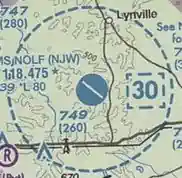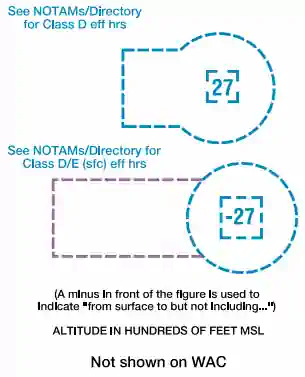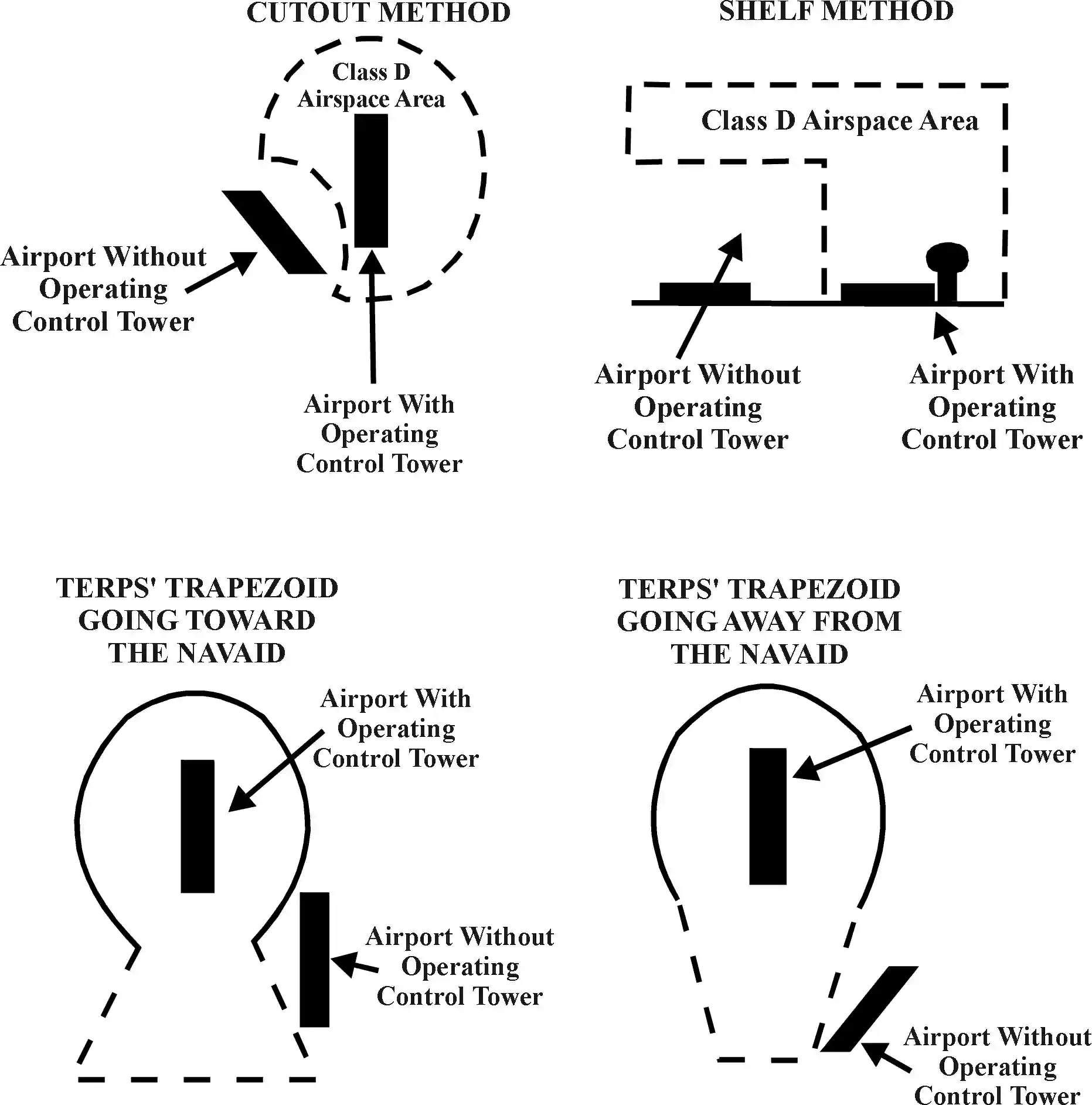Class Delta Air Traffic Services:
- Class D surface areas may be full-time (24-hour tower operations) or part-time
- Part-time Class D effective times are published in the Chart Supplement in Coordinated Universal Time (UTC), also known as "Zulu" time [Figure 1]
- When anticipating minor variations in hours of operation, Notice to Air Missions (NOTAMs) will be issued stating, "This surface area is effective during the specific dates and times established, in advance, by a Notice to Air Missions"
- Where a Class D surface area is part-time, the airspace may revert to either a Class E surface area or Class G airspace
- During the hours the tower is not in operation, the Class E surface area rules or a combination of Class E rules to 700' above the ground level and Class G rules to the surface will become applicable
- When a part–time Class D surface area changes to Class G, the surface area becomes Class G airspace up to, but not including, the overlying controlled airspace
- The airport listing in the Chart Supplement U.S. will state the part–time surface area status (for example, "other times CLASS E" or "other times CLASS G")
- Normally, the overlying controlled airspace is the Class E transition area airspace that begins at either 700 feet AGL (charted as a magenta vignette) or 1200 feet AGL (charted as a blue vignette)
- Consult applicable Visual Flight Rules (VFR) Sectional or Terminal Area Charts
Class Delta Airspace Dimensions:
- The configuration of each Class D airspace area is individually tailored to:
- Contain the intended operations;
- Allow for safe and efficient handling of operations, and;
- When instrument procedures are published, contain Instrument Flight Rules (IFR) arrival operations while between the surface and 1,000 feet above the surface and IFR departure operations while between the surface and the base of adjacent controlled airspace
- Arrival extensions for instrument approach procedures (IAPs) may be Class D or Class E airspace
- If all extensions are 2 miles or less, they generally remain part of the Class D surface area
- If any extension is greater than 2 miles, then all extensions become Class E
-
Horizontal Limits:
- Class D areas are tailored to the area, but the standard radius surrounding those airports that have an operational control tower is 4.4 Nauical Miles (NM)/5 Statute Miles (SM) [Figure 2/3]
- Exact details, to include the formula for determining Class D airspace width for a given location and the associated class E surrounding area, can be found in the Federal Aviation Administration JO 7400.2 (series):
- The technical formula for class D radius is: R = D/6076 + 3.5
- For example:
- At Airport A, the distance from the geographic position to the end of the outermost runway is 4,023 feet; therefore, assuming flat terrain, the radius is calculated as: R = 4023/6076 + 3.5 = .662 + 3.5 = 4.162 = 4.2
- The radius for the 700-foot Class E airspace becomes: 4.2 + 2.5 = 6.7
- To ensure that the lateral boundary of the Class D area is congruent with the beginning of the 700-foot Class E airspace, the specialist must:
- Search the Class D area's radius circle for the highest terrain
- Calculate the MSL height of the aircraft by adding 700 feet to the airport elevation
- Compare MSL altitudes of the aircraft versus the highest terrain to determine if the aircraft has reached the overlying or adjacent controlled airspace. If not, increase the size of the Class D area, as necessary, to contain the departure
-
Vertical Limits:
- Class D areas generally extend upward from the surface up to and including 2,500 feet AGL [Figure 2/3]
- In a low density or non-turbo aircraft traffic environment, a vertical limit of 2,500 feet Above Ground Level (AGL) may be excessive, necessitating a lower ceiling
- Vertical boundaries of class D airspace are delineated with cyan numbers
- The altitude which the airspace extends is written inside cyan brackets, representing "up to and including" the designated altitude
- When a - is displayed in front of the number, it means "up to and not including"
- Altitude dimensions are based on AGL but charted in Mean Sea Level (MSL)
- The size of a Class D area, and any necessary extensions, is determined by the use of a 200 feet per NM climb gradient and information obtained from the person responsible for developing instrument procedures [Figure 3]
- Normally, the person responsible for developing instrument procedures for civil and U.S. Army airports is an FAA Aviation Standards Airspace Evaluation Specialist
- A military representative handles all other military procedures
- Generally, separate Class D airspace areas will be established for airports in proximity to each other to eliminate satellite airports as practical [Figure 3]
- A common boundary line ensures the airspace areas do not overlap
- When operationally advantageous, the common boundary separating adjacent Class D areas may be eliminated if the areas are contained in an existing Class B or Class C airspace area controlled by the same IFR Air Traffic Control (ATC) facility
Class Delta Airspace Depiction:
- On Sectional and Terminal charts, Class D airspace areas are depicted with blue segmented lines [Figure 4]
- The primary airport is indicated by a blue symbol
- On IFR En Route Lows, Class D is only recognized by a boxed [D] in the airport information [Figure 5/6]
Operating Rules and Pilot/Equipment Requirements:
-
Pilot Certification:
- There is no specific pilot certification required
- As long as an aircraft meets the equipment requirements below, anyone from a student on up can operate within Class Charlie Airspace
-
Equipment:
- Unless otherwise authorized by ATC, an operable two-way radio is required
-
VFR Visibility Requirements:
- 3 SM visibility, 500' below, 1,000' above, 2,000' horizontal
- Under Special VFR, if granted by the controller, a pilot may enter or leave Class D Airspace in 1 statute mile of visibility while remaining clear of clouds
-
Speed Restrictions:
- Unless otherwise authorized or required by ATC, no person may operate an aircraft at or below 2,500' AGL within 4 NM of the primary airport of a Class D airspace area at an indicated airspeed of more than 200 knots (230 mph)
-
Aircraft Separation:
- IFR, Special VFR (SVFR), and runway operations
- No separation provided for VFR operations
-
Arrival or Through Flight Entry Requirements:
- Two-way radio communication (either direct or rapid relay through other facilities which are acceptable to the ATC facility) must be established with the ATC facility providing ATC services, on the publicized frequency, before entry and thereafter maintain those communications while in the Class D airspace
- When close to the airport, listen for the Automatic Terminal Information System (ATIS)/Automated Weather Observation System (AWOS)/Automated Surface Observation System (ASOS)
- Calls should be initiated far enough from the Class D airspace boundary to preclude entering before two-way communications are established
- Pilot: "[Tower], [Callsign], [Position], [Altitude], [Destination], [ATIS/AWOS/ASOS Information] [Request(s)/Intention(s)]"
- Example: "Montgomery Tower, Cessna 1727V, 10-miles to the West, five thousand feet inbound to Montgomery, information Quebec request touch and goes"
- The requirement to maintain two-way radio communications is satisfied when the pilot hears their callsign in response to their call
- ATC: "[Callsign], [Tower], [Altimeter], [Instructions]"
- Example: "Cessna 1727V, Montgomery Tower, altimeter 30.03, report 3-mile left base for runway 36"
- Example: "Cessna 1727V, standby"
- Example: "Cessna 1727V, remain outside the Class Delta airspace and standby"
- It is important to understand that if the controller responds to the initial radio call without using the aircraft callsign, radio communications are not yet established, and the pilot may not enter the Class D airspace
- ATC: "Aircraft calling, standby"
- If workload or traffic conditions prevent immediate entry into Class D airspace, the controller will inform the pilot to remain outside the Class D airspace until conditions permit entry
- ATC: "Aircraft calling, remain outside Class Delta airspace and standby"
- At those airports where the control tower does not operate 24 hours a day, the operating hours of the tower will be listed on the appropriate charts and in the Chart Supplement U.S. During the hours the tower is not in operation, the Class E surface area rules or a combination of Class E rules to 700' AGL and Class G rules to the surface will become applicable
- Check the Chart Supplement U.S. for specifics
-
Class Delta Departures:
- Tower provides takeoff, landing, and sometimes taxi clearance (at small airports, ground and tower are the same person)
- No person may, at any airport with an operating control tower, operate an aircraft on a runway or taxiway or takeoff or land an aircraft unless receiving an appropriate clearance from ATC
- An operator may deviate from any provision of this section under the provisions of an ATC authorization issued by the ATC facility having jurisdiction over the airspace concerned
- ATC may authorize a standing deviation or for an individual flight, as appropriate
- From the primary airport or satellite airport with an operating control tower, the pilot must establish and maintain two-way radio communications with the control tower, and thereafter as instructed by ATC while operating in the Class D airspace area
- From a satellite airport without an operating control tower, the pilot must establish and maintain two-way radio communications with the ATC facility having jurisdiction over the Class D airspace area as soon as practicable after departing
- When operating out of a satellite airport, contact tower for arrival and departures as soon as practicable
- Each pilot must comply with any departure procedures established for that airport by the FAA
- Unless otherwise required by the prescribed departure procedure or the applicable distance from clouds criteria, each pilot of a turbine-powered airplane and each pilot of a large airplane must climb to an altitude of 1,500' above the surface as rapidly as practicable
-
Small Unmanned Aircraft Operations:
- No person may operate a small unmanned aircraft in Class D airspace unless that person has prior authorization from Air Traffic Control (ATC)
- No person may operate a small unmanned aircraft in a manner that interferes with operations and traffic patterns at any airport, heliport, or seaplane base
Weather Observations and Reporting:
- Weather observations are taken at the primary airport during the times and dates the Class D airspace is active by either a federally certified weather observer or a federally commissioned automated weather observing system
- This includes all FAA and National Weather Service (NWS) approved and certified weather reporting systems
- The weather observer will take routine (hourly) and special observations, called METARs
- An automated weather observing system can provide continuous weather observations, called AWOS/ASOS
- Scheduled record and special observations from weather observers or automated weather reporting systems must be made available to the ATC facility(s) having control jurisdiction over the Class D designated surface area
- This can be accomplished through Flight Service Station (FSS), Longline Dissemination, NWS, or other FAA-approved sources
- Facilities that require weather reports from satellite airports may enter into a letter of agreement (LOA) with the associated FSS, airline/contract observer, airport management, etc.
- At ATC sites where non-Federal employees perform weather duties, the appropriate FAA office supervises reporting and dissemination requirements applicable to National Weather Service and FAA publication standards
- In facilities where direct access to automated weather observing systems is not available, controllers will apply the provisions of FAAO 7110.65, Air Traffic Control
- Should these services be unavailable, a NOTAM will be issued
Restrictions:
- Arrival Extensions:
- Arrival extensions for IAPs may be Class Delta or Echo airspace
- A Class D area arrival extension must be established to the point where an IFR flight on an instrument approach can be expected to descend to less than 1,000 feet above the surface
- The width of the extension must be equal to the width of the TERPs primary obstruction clearance area at the widest point where an IFR flight on an instrument approach can be expected to descend to an altitude below 1,000 feet above the surface
- Extensions must, in all cases, extend to a minimum of 1 NM on each side of the centerline
- If all arrival extensions are 2 NM or less, they will remain part of the basic Class D area
- However, if an extension is greater than 2 NM, then all extensions will be Class E airspace
- Unless required by the applicable distance-from-cloud criteria, each pilot operating a large or turbine-powered airplane must enter the traffic pattern at an altitude of at least 1,500' above the elevation of the airport and maintain at least 1,500' until further descent is required for a safe landing
- Surface Area Arrival Extensions:
- Arrival extensions for instrument approach procedures may be Class D or Class E airspace
- As a rule of thumb:
- If all extensions are 2 miles or less, they remain part of the Class D surface area
- If an extension is greater than 2 miles, then all extensions become Class E
- Surface area arrival extensions are effective during the published times of the surface area
- For part–time Class D surface areas that revert to Class E airspace, the arrival extensions will remain in effect as Class E airspace
- For part–time Class D surface areas that change to Class G airspace, the arrival extensions will become Class G at the same time
Private Pilot - National Airspace System Airman Certification Standards:
- Applicants must satisfy the requirements of Section I, Task E by exhibiting satisfactory knowledge, risk management, and skills associated with the National Airspace System (NAS) operating under VFR as a private pilot
- References: 14 CFR parts 71, 91, 93; FAA-H-8083-2; Navigation Charts; AIM
National Airspace System Knowledge:
The applicant must demonstrate an understanding of:PA.I.E.K1:
Types of airspace/airspace classes and associated requirements and limitations-
PA.I.E.K2:
Charting symbology PA.I.E.K3:
Special use airspace (SUA), special flight rules areas (SFRA), temporary flight restrictions (TFR), and other airspace areas
National Airspace System Risk Management:
The applicant demonstrates the ability to identify, assess, and mitigate risks, encompassing:-
PA.I.E.R1:
Various classes and types of airspace
National Airspace System Skills:
The applicant demonstrates the ability to:-
PA.I.E.S1:
Identify and comply with the requirements for basic VFR weather minimums and flying in particular classes of airspace -
PA.I.E.S2:
Correctly identify airspace and operate in accordance with associated communication and equipment requirements -
PA.I.E.S3:
Identify the requirements for operating in SUA or within a TFR. Identify and comply with SATR and SFRA operations, if applicable
Conclusion:
- Class Delta Airspace areas do not provide radar services, as in Class Bravo or Charlie airspace
- Unless otherwise authorized or required by the Air Traffic Control (ATC) facility having jurisdiction over the Class D airspace area, each person operating an aircraft in Class D airspace must comply with the applicable provisions of FAR 91.129
- Each person must comply with Federal Aviation Regulation (FAR) 91.126 and 91.127
- Local FAA offices review Class Delta Airspace areas biennially to evaluate safety and policy compliance
- Remember to comply with all noise abatement procedures found in the Chart Supplement U.S.
- The primary airport is always the airport for which the Class D airspace area is designated, whereas the satellite airport is any other airport within the Class D airspace area
- See also: CFI Notebook.net - Aviation Roles
- Turbine aircraft will operate at 1,500' AGL in the pattern until in a position to make a safe landing
- Circle to the left and avoid the flow of fixed-wing traffic if operating a helicopter
- Each pilot operating a large or turbine-powered airplane approaching to land on a runway served by an instrument approach procedure with vertical guidance, if the airplane is so equipped, must:
- Operate that airplane at an altitude at or above the glide path between the published final approach fix and the decision altitude (DA), or decision height (DH), as applicable; or
- If compliance with the applicable distance-from-cloud criteria requires glide path interception closer in, operate that airplane at or above the glide path, between the point of interception of glide path and the DA or the DH
- Where the FAA has established a formal runway use program, each pilot of a large or turbine-powered airplane assigned a noise abatement runway by ATC must use that runway. However, consistent with the final authority of the pilot in command concerning the safe operation of the aircraft, ATC may assign a different runway if requested by the pilot in the interest of safety
- If two-way radio communications are lost during operations inside of class Delta airspace, follow the appropriate lost communication procedures
- Still looking for something? Continue searching:
References:
- Aeronautical Information Manual (3-2-5) Class Delta Airspace
- Aeronautical Information Manual (4-3-2) Airports with an Operating Control Tower
- AeroNav Products - Aeronautical Chart User's Guide
- Airnav.com
- BoldMethod - The VFR Pilot's Guide For Landing At Busy Airports
- Federal Aviation Administration Order 7400.2 (series) Procedures for Handling Airspace Matters
- Federal Aviation Administration - National Flight Data Digest (NFDD)
- Federal Aviation Administration - Pilot/Controller Glossary
- Federal Aviation Administration Order (7400.2, Chapter 17) Procedures for Handling Airspace Matters
- Federal Aviation Administration Order (7400.9) Airspace Designations and Reporting Points
- Federal Aviation Regulations (Part 71 subpart D) Class D Airspace
- Federal Aviation Regulations (91.126) Operating on or in the vicinity of an airport in Class G airspace
- Federal Aviation Regulations (91.127) Operating on or in the vicinity of an airport in Class E airspace
- Instrument Flying Handbook (1-2) Airspace Classification




